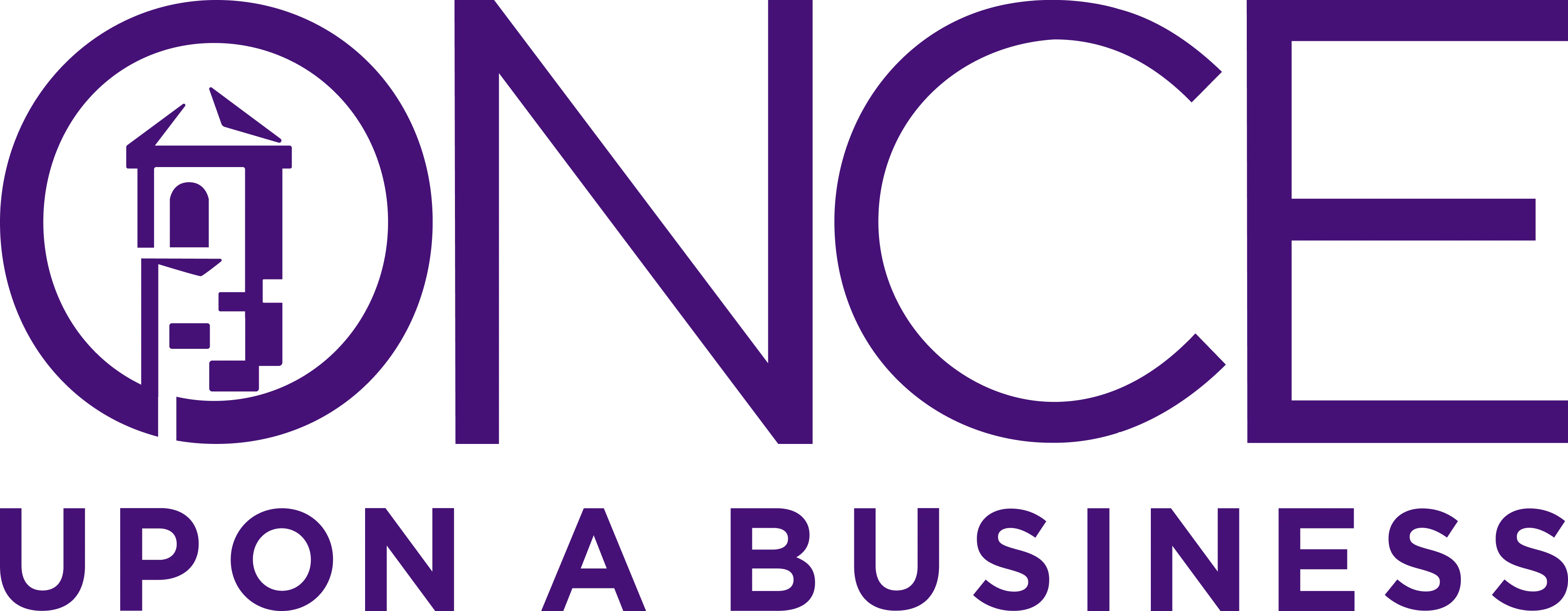
I could replace 90% of company websites with Lorem Ipsum text, and nobody would notice the difference. That's because most brands don't have personalities—they have corporate-speak generators that churn out the same meaningless buzzwords: "innovative," "customer-focused," "results-driven," "synergistic solutions."
Here's the uncomfortable truth: When every brand sounds exactly the same, customers make decisions purely on price or convenience, never loyalty.
After 25 years of watching businesses struggle with bland, forgettable messaging, I can tell you that the problem isn't a lack of creativity—it's a lack of strategic framework. Most brands sound generic because they have no guiding principle for tone, voice, and messaging decisions. Every piece of content becomes a random creative exercise instead of a consistent expression of brand personality.
Brand archetypes aren't about being different from your competition. They're about being intentional.
They provide a psychological foundation that ensures every piece of communication feels purposeful and cohesive, rather than random and corporate. When you have a clear archetype framework, you stop defaulting to generic business-speak because you have a strategic filter for every communication decision.
What Brand Archetypes Actually Are (And What They're Not)
Let me be clear: brand archetypes aren't limiting creative boxes or personality tests for your business. They're strategic frameworks based on Carl Jung's research into universal psychological patterns that humans instinctively recognize and respond to across all cultures and contexts.
The science is simple: Humans are wired to categorize and understand personalities through predictable patterns. These patterns exist in our stories, our heroes, our relationships, and yes—our brand preferences. When a brand consistently embodies one of these patterns, customers subconsciously understand who that brand is and what it stands for, creating faster trust and deeper connection.
Here's what archetypes actually do for your business:
- Provide a consistent filter for all messaging decisions
- Create subconscious familiarity and trust with customers
- Give your team a clear framework for brand voice across all touchpoints
- Prevent the random, scattered messaging that makes brands forgettable
Here's what they don't do:
- Limit your creativity or constrain your content
- Guarantee differentiation from competitors
- Replace good strategy or quality products
- Work as one-time creative exercises instead of systematic frameworks
The key insight that most businesses miss: Customers don't buy products; they buy relationships with brands that feel familiar, trustworthy, and aligned with their own values. Archetypes are the psychological shortcut to that connection.
The Psychology Behind Why Archetypes Work in Business
Brand archetypes work because they tap into fundamental human psychology that operates below conscious thought.
When someone encounters your brand, their brain immediately starts categorizing: Is this brand like me? Can I trust them? Do they understand my world? This happens in milliseconds, long before rational evaluation of features, benefits, or pricing.
Archetypes accelerate this process by providing psychological shortcuts. When your brand consistently embodies the Hero archetype, customers immediately understand that you're about overcoming challenges, achieving goals, and inspiring greatness. When you embody the Caregiver archetype, they instantly know you're about protection, service, and nurturing support.
This isn't manipulation—it's strategic clarity. Instead of forcing customers to figure out who you are through trial and error, archetypes provide a clear, consistent personality framework that builds trust through familiarity.
The business impact is measurable:
- Faster customer recognition and recall
- Higher emotional engagement with your messaging
- Increased willingness to pay premium prices
- Stronger customer loyalty and advocacy
- More consistent team execution of brand voice
But here's the critical point: Archetypes only work when applied systematically across every customer touchpoint. A Hero brand that sounds like a Caregiver in customer service and a Ruler in sales materials confuses customers and undermines trust.
The 12 Brand Archetypes: Your Strategic Personality Menu
The 12 archetypes are organized around four fundamental human motivations. Understanding these motivations helps you choose the archetype that aligns with your business model and customer needs, rather than just picking one that sounds appealing.
![Brand Archetypes: The Definitive Guide [36 Examples]](https://cdn.prod.website-files.com/688f5d8f4b93cedd9626c7f9/68c7fd5f35162a2e56c4784f_iconic-fox-Atchetypes-12-jungian-map.jpeg)
Provide Structure: Safety and Control-Oriented Archetypes
These archetypes appeal to customers who value stability, reliability, and predictable outcomes. They work best for businesses that provide security, guidance, or premium quality.
The Caregiver
- Core Motivation: To help and protect others
- Personality Traits: Caring, nurturing, protective, generous, compassionate, selfless
- Brand Voice: Warm, supportive, gentle, reassuring, empathetic
- Strategic Application: Perfect for healthcare, education, non-profits, and service-oriented businesses where the customer's wellbeing is the primary concern.
- When It Works: When your business genuinely exists to serve others' needs rather than your own profit
- Brand Examples: Johnson & Johnson (caring for families), UNICEF (protecting children), Salvation Army (helping those in need)
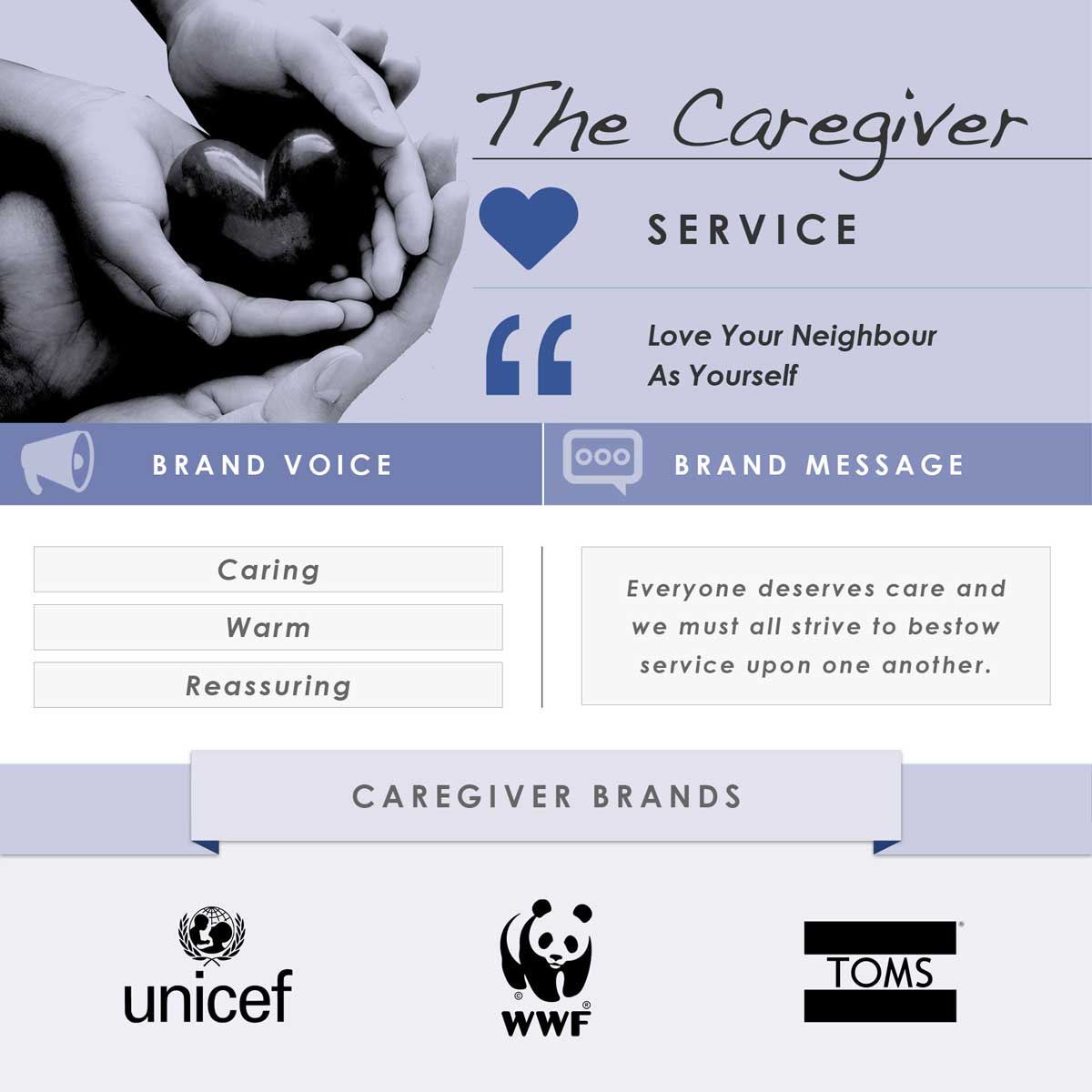
The Ruler
- Core Motivation: To create prosperity and success
- Personality Traits: Responsible, authoritative, sophisticated, premium, exclusive, powerful
- Brand Voice: Confident, commanding, refined, prestigious, authoritative
- Strategic Application: Luxury brands, premium services, leadership-focused businesses, and companies targeting high-achievers and status-conscious customers.
- When It Works: When you can deliver genuinely premium quality and exclusive experiences that justify higher prices
- Brand Examples: Mercedes-Benz (luxury and status), Rolex (prestigious timekeeping), IBM (business leadership and authority)
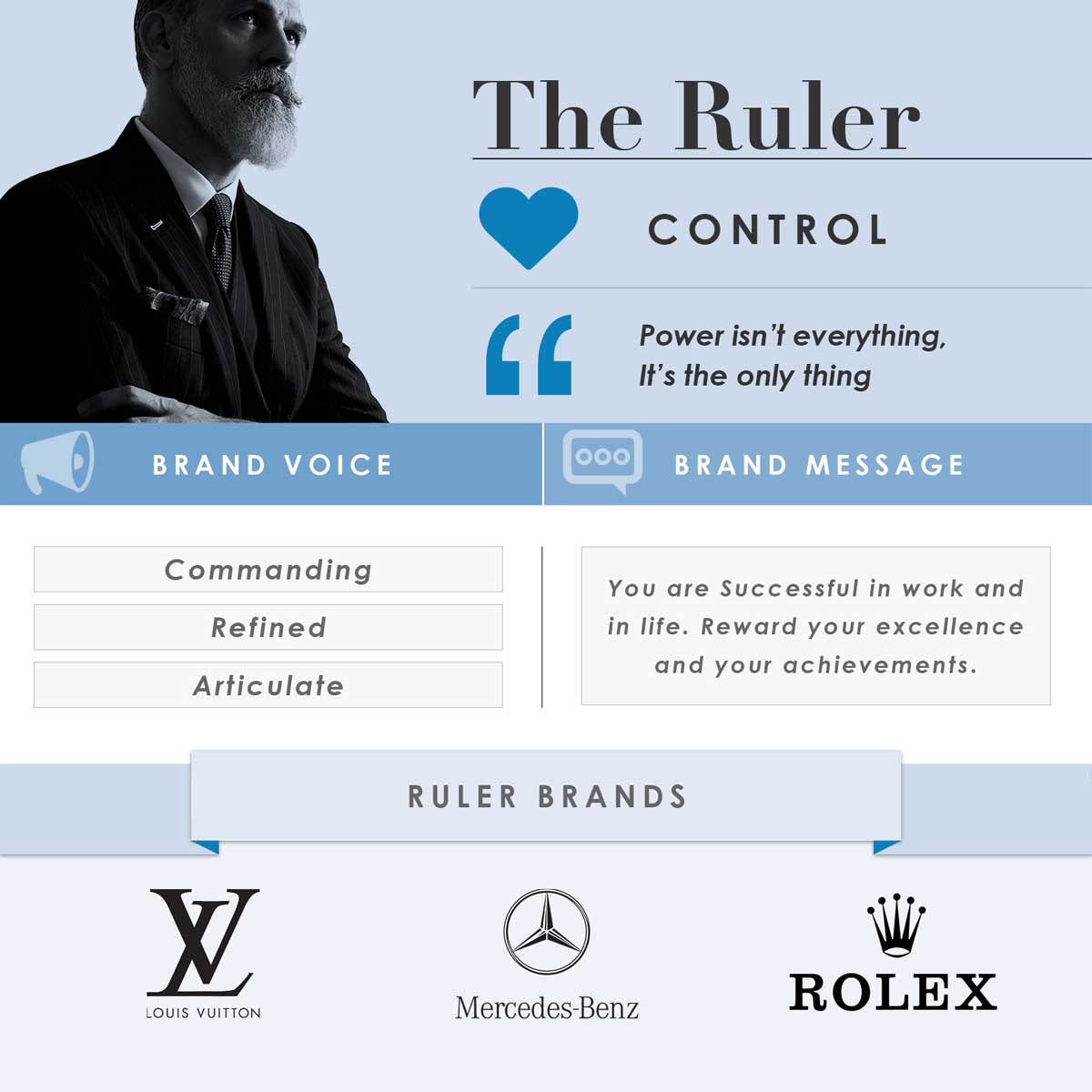
The Creator
- Core Motivation: To create something of enduring value
- Personality Traits: Creative, imaginative, inventive, artistic, non-conformist, ambitious
- Brand Voice: Inspiring, artistic, imaginative, encouraging creativity, sophisticated
- Strategic Application: Creative tools, artistic products, DIY platforms, and brands that help customers express themselves or build something meaningful.
- When It Works: When your business genuinely enables customer creativity or self-expression
- Brand Examples: LEGO (enabling creative building), Adobe (creative tools), Pinterest (inspiring creativity)
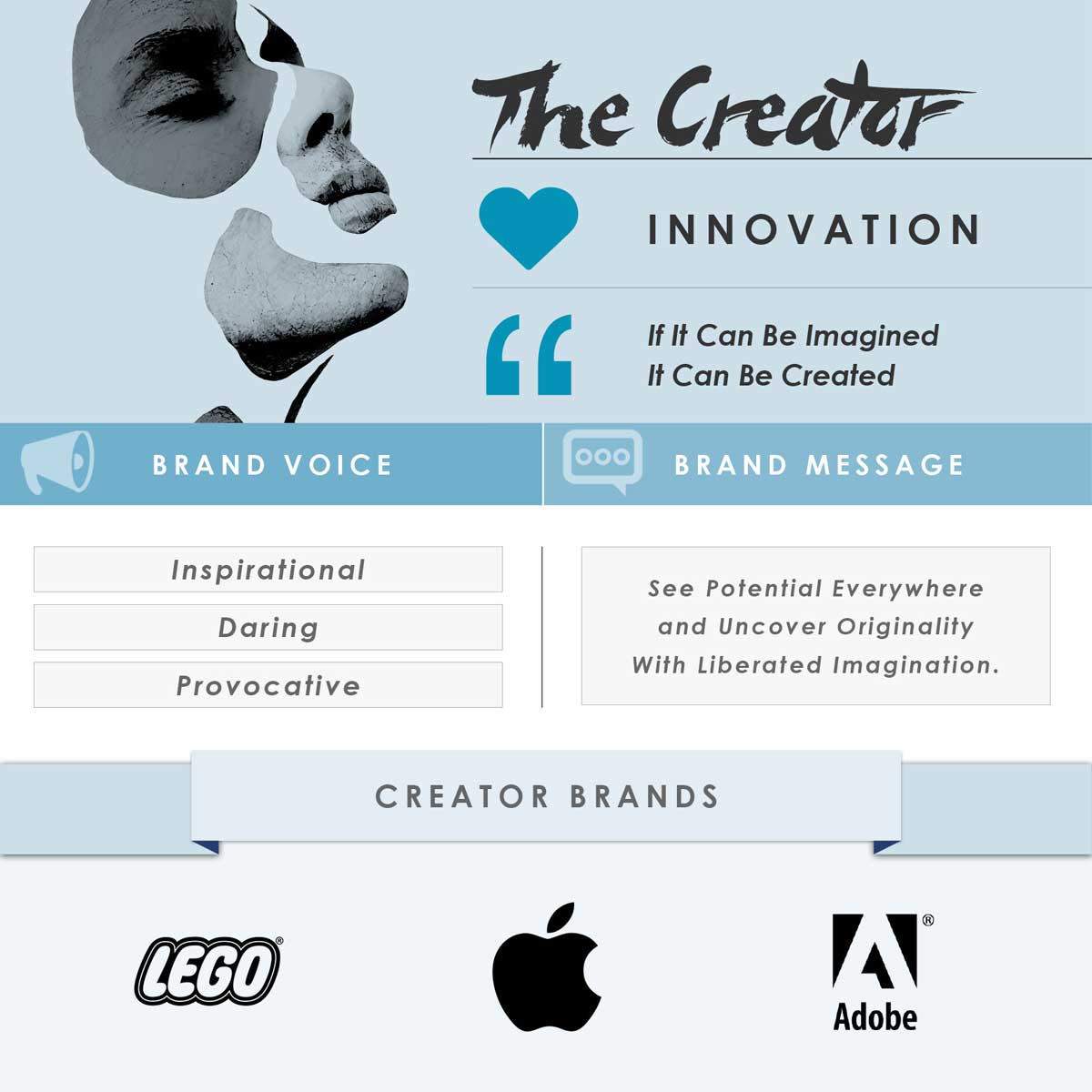
Leave a Mark: Legacy and Achievement-Oriented Archetypes
These archetypes appeal to customers who want to achieve something meaningful, create change, or leave their mark on the world.
The Hero
- Core Motivation: To prove worth through courageous action
- Personality Traits: Courageous, determined, honest, inspirational, ambitious, resilient
- Brand Voice: Motivational, confident, direct, challenging, empowering
- Strategic Application: Sports brands, fitness, personal development, and any business that helps customers overcome challenges or achieve difficult goals.
- When It Works: When your product/service genuinely helps people accomplish something difficult or important
- Brand Examples: Nike (athletic achievement), FedEx (delivering against all odds), BMW (driving performance)
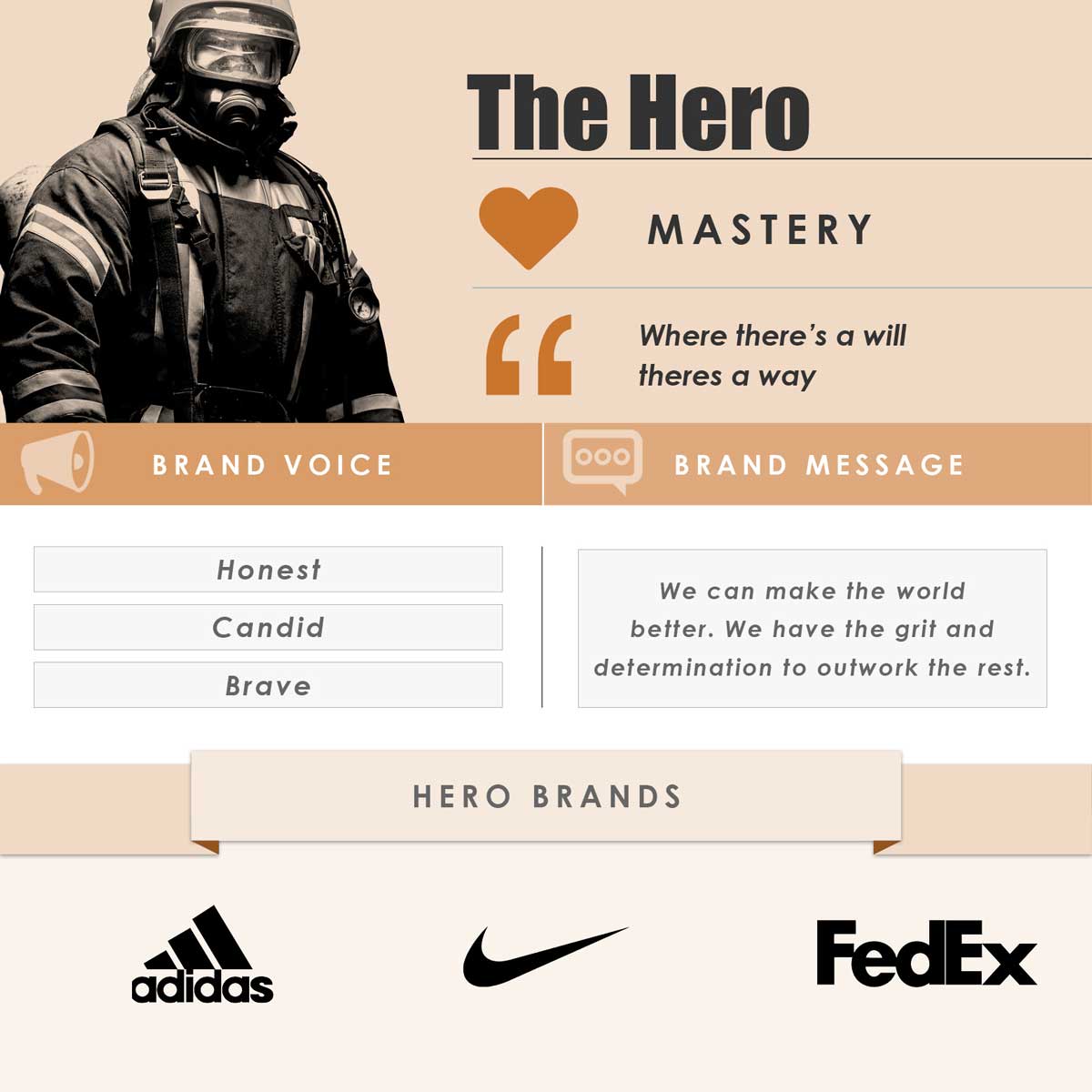
The Outlaw
- Core Motivation: To overturn what isn't working and create change
- Personality Traits: Rebellious, wild, disruptive, revolutionary, authentic, free-spirited
- Brand Voice: Bold, provocative, unconventional, authentic, anti-establishment
- Strategic Application: Brands that challenge industry norms, appeal to non-conformists, or offer genuine alternatives to mainstream solutions.
- When It Works: When you're actually disrupting established industries or serving customers who feel underserved by traditional options
- Brand Examples: Harley-Davidson (freedom and rebellion), Virgin (challenging established industries), Patagonia (environmental activism)
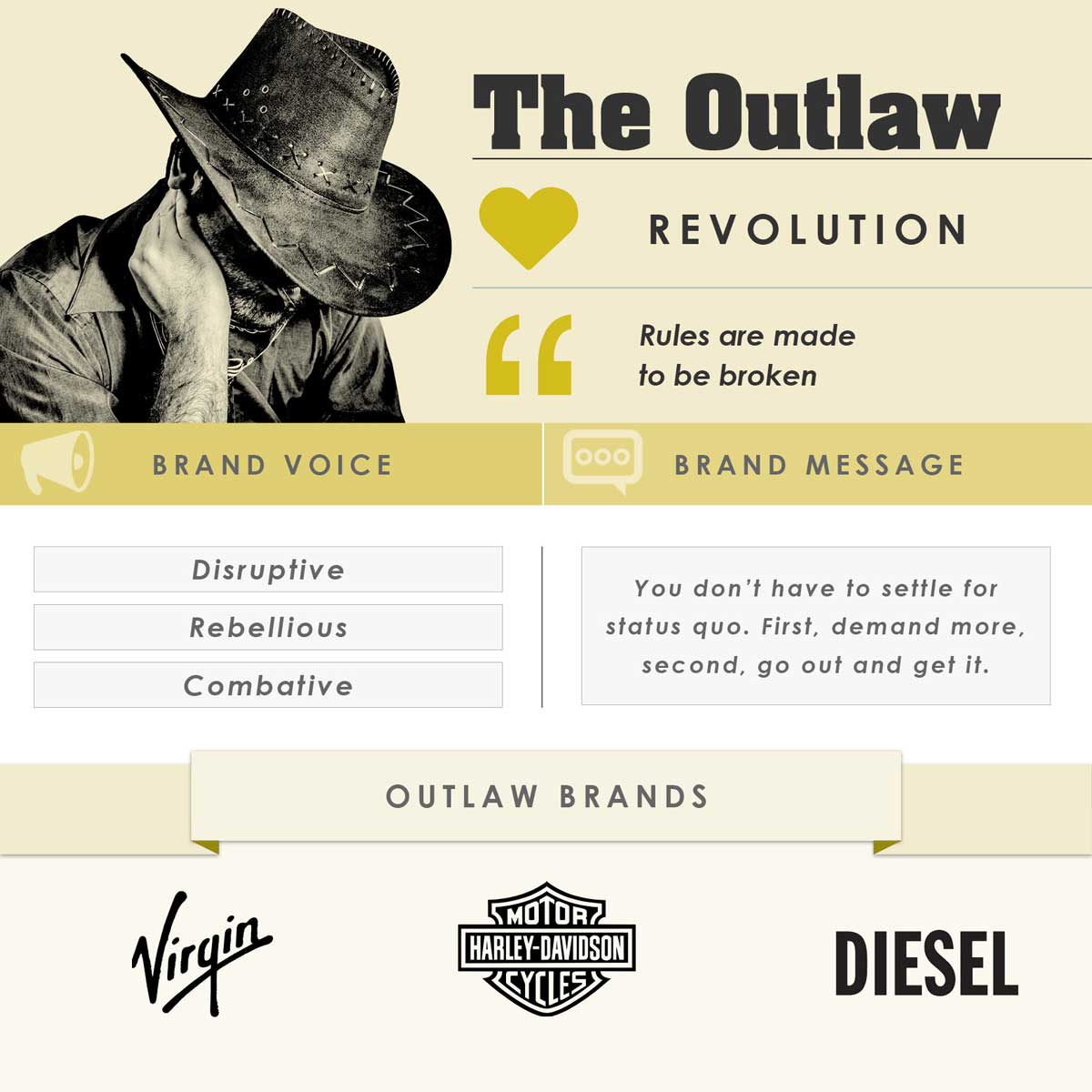
The Magician
- Core Motivation: To make dreams come true and transform reality
- Personality Traits: Visionary, innovative, transformative, imaginative, inspiring, mystical
- Brand Voice: Inspiring, mystical, transformative, visionary, wonder-filled
- Strategic Application: Technology companies, entertainment, luxury experiences, and brands that genuinely transform how people live or work.
- When It Works: When your product/service creates genuine transformation or seemingly impossible experiences
- Brand Examples: Apple (technology that transforms lives), Disney (creating magical experiences), Tesla (transforming transportation)
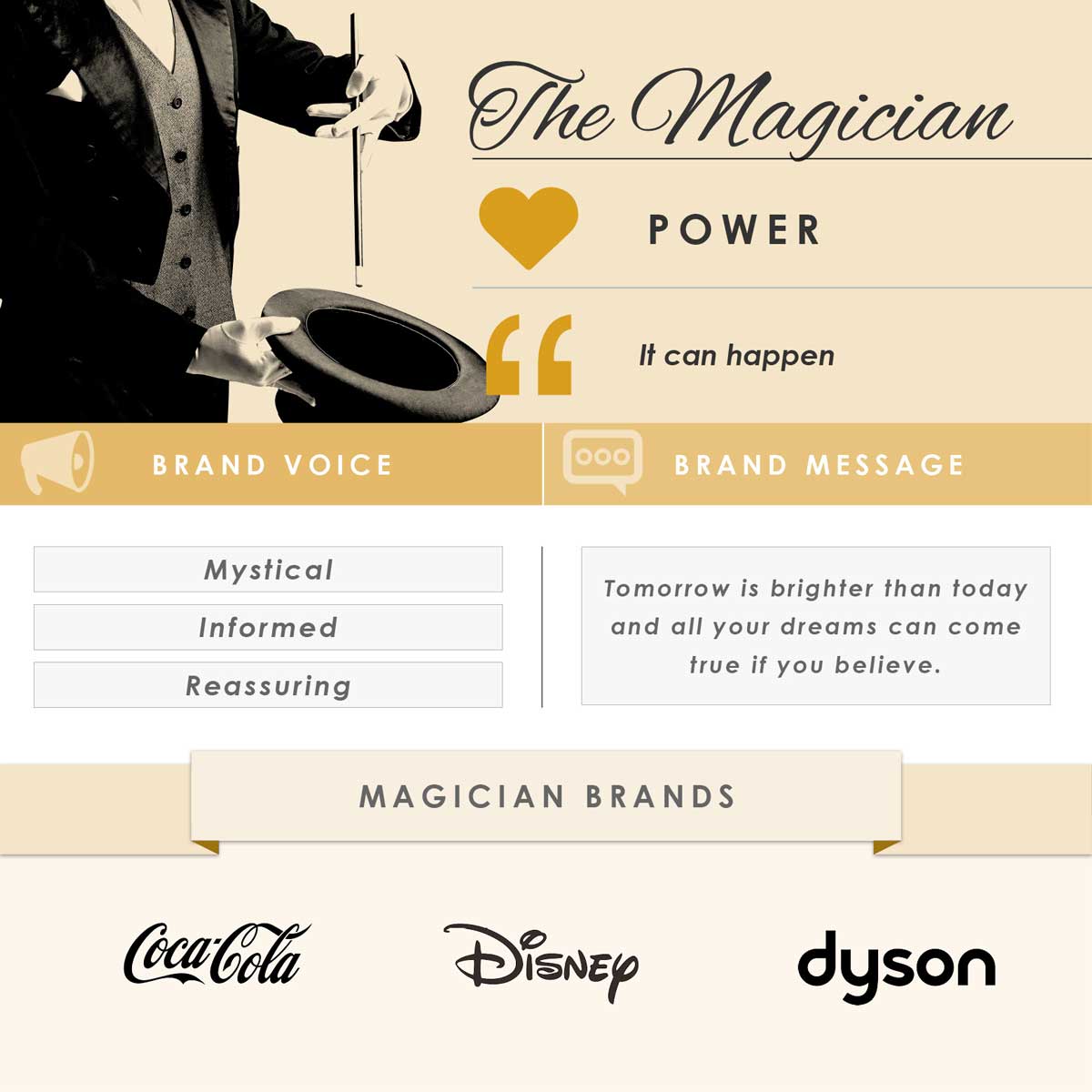
Connect to Others: Relationship and Community-Oriented Archetypes
These archetypes focus on building relationships, creating connections, and fostering community or intimacy.
The Lover
- Core Motivation: To find and give love, build relationships
- Personality Traits: Passionate, romantic, sensual, committed, intimate, devoted
- Brand Voice: Passionate, intimate, seductive, romantic, indulgent, emotional
- Strategic Application: Luxury goods, beauty, fashion, jewelry, and experiences that enhance relationships or personal attractiveness.
- When It Works: When your product/service genuinely enhances relationships, intimacy, or personal appeal
- Brand Examples: Victoria's Secret (intimate appeal), Chanel (luxury and sensuality), Godiva (indulgent experiences)
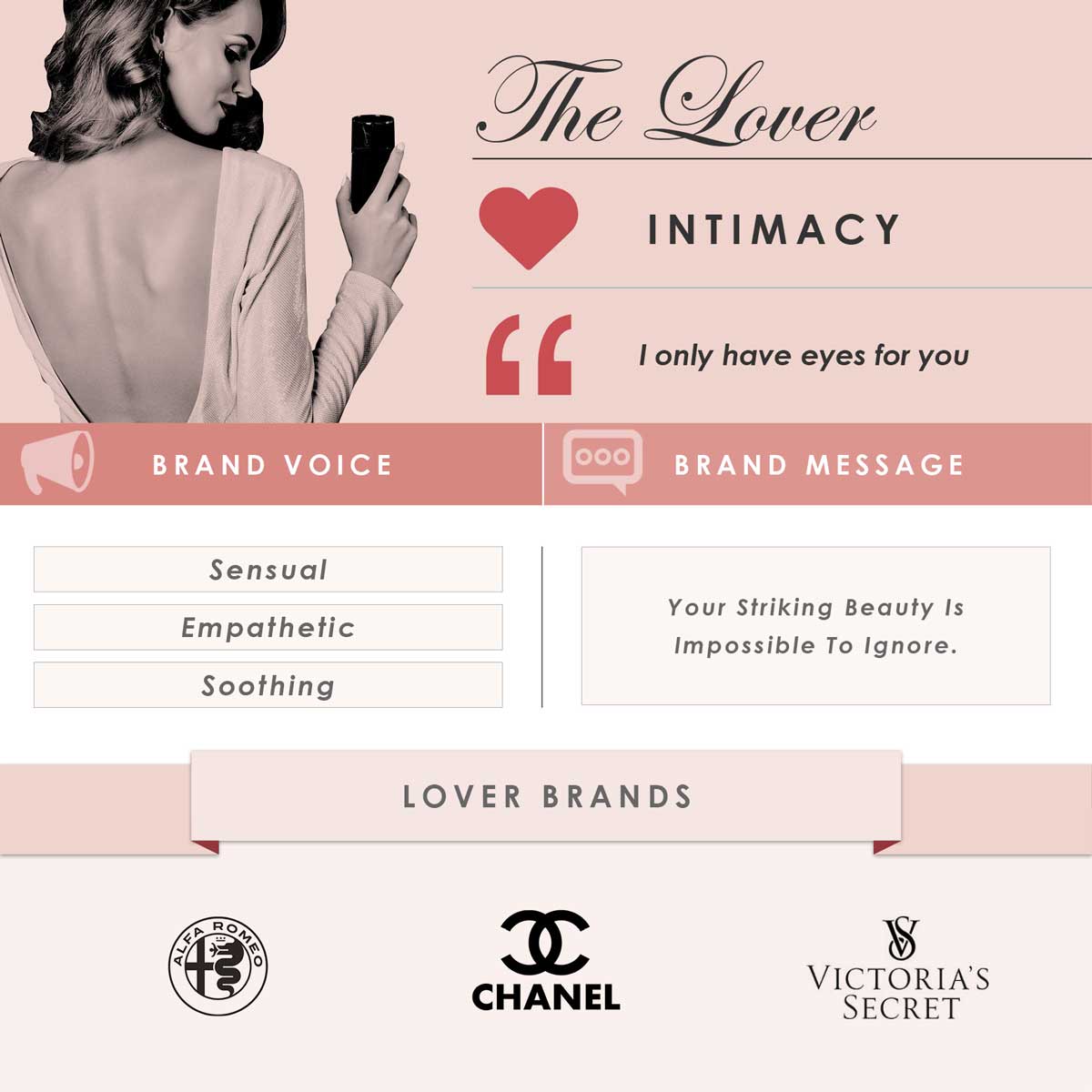
The Jester
- Core Motivation: To live in the moment and enjoy life
- Personality Traits: Playful, humorous, irreverent, fun-loving, spontaneous, optimistic
- Brand Voice: Funny, irreverent, playful, entertaining, light-hearted, spontaneous
- Strategic Application: Entertainment, casual dining, consumer products that don't take themselves too seriously, and brands targeting younger demographics.
- When It Works: When fun and enjoyment are genuinely central to your product experience, not just marketing gimmicks
- Brand Examples: Old Spice (humorous masculinity), Ben & Jerry's (playful activism), M&M's (colorful fun)
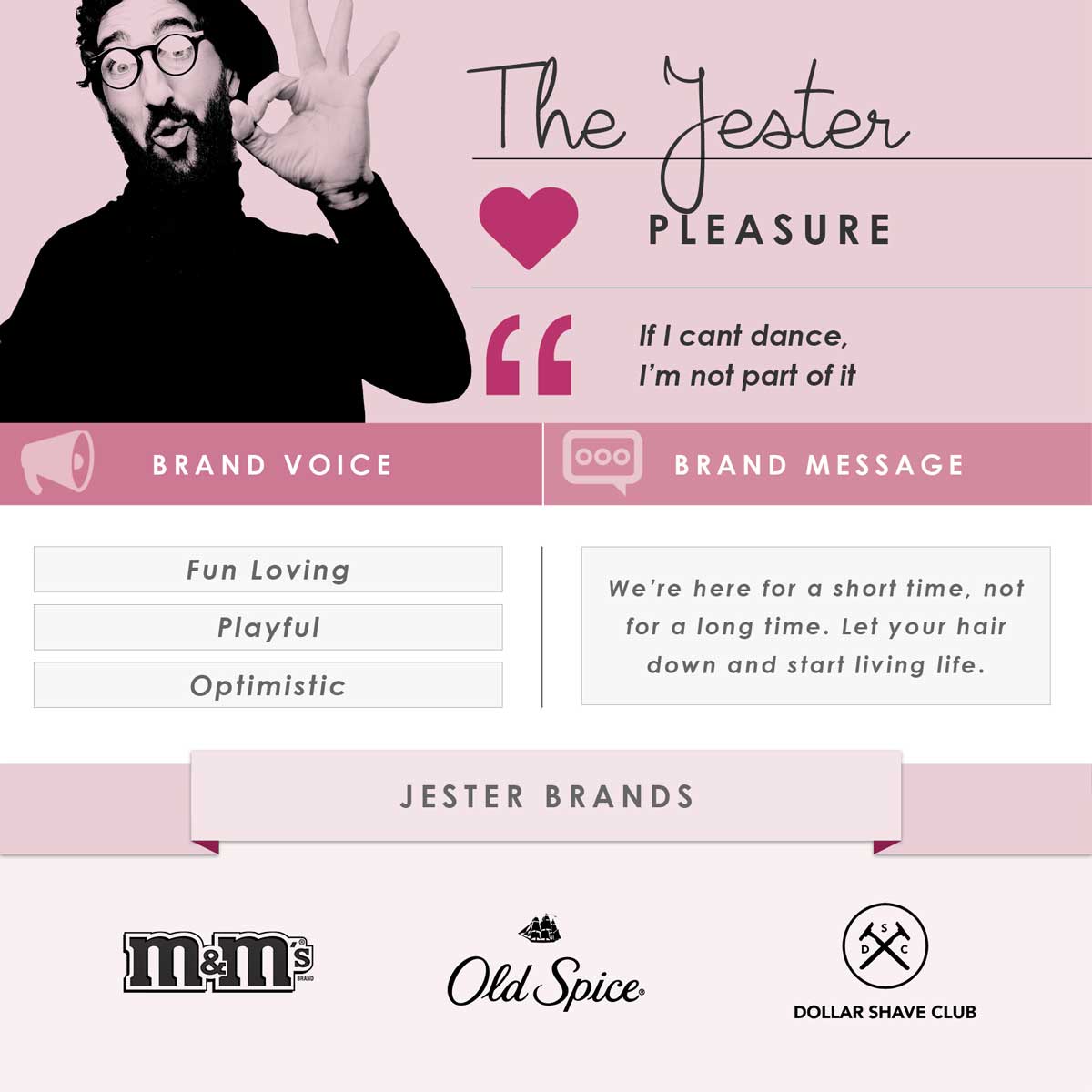
The Everyman
- Core Motivation: To belong and connect with others
- Personality Traits: Down-to-earth, relatable, friendly, practical, humble, authentic
- Brand Voice: Conversational, unpretentious, inclusive, helpful, accessible
- Strategic Application: Ideal for brands that want to feel democratic, accessible, and "for everyone." Particularly effective for mass-market products, home improvement, and everyday essentials.
- When It Works: When you want to be seen as the reliable choice for regular people, not just the wealthy or sophisticated
- Brand Examples: IKEA (democratic design for everyone), Home Depot (helping regular people with home projects), Target (affordable style for families)
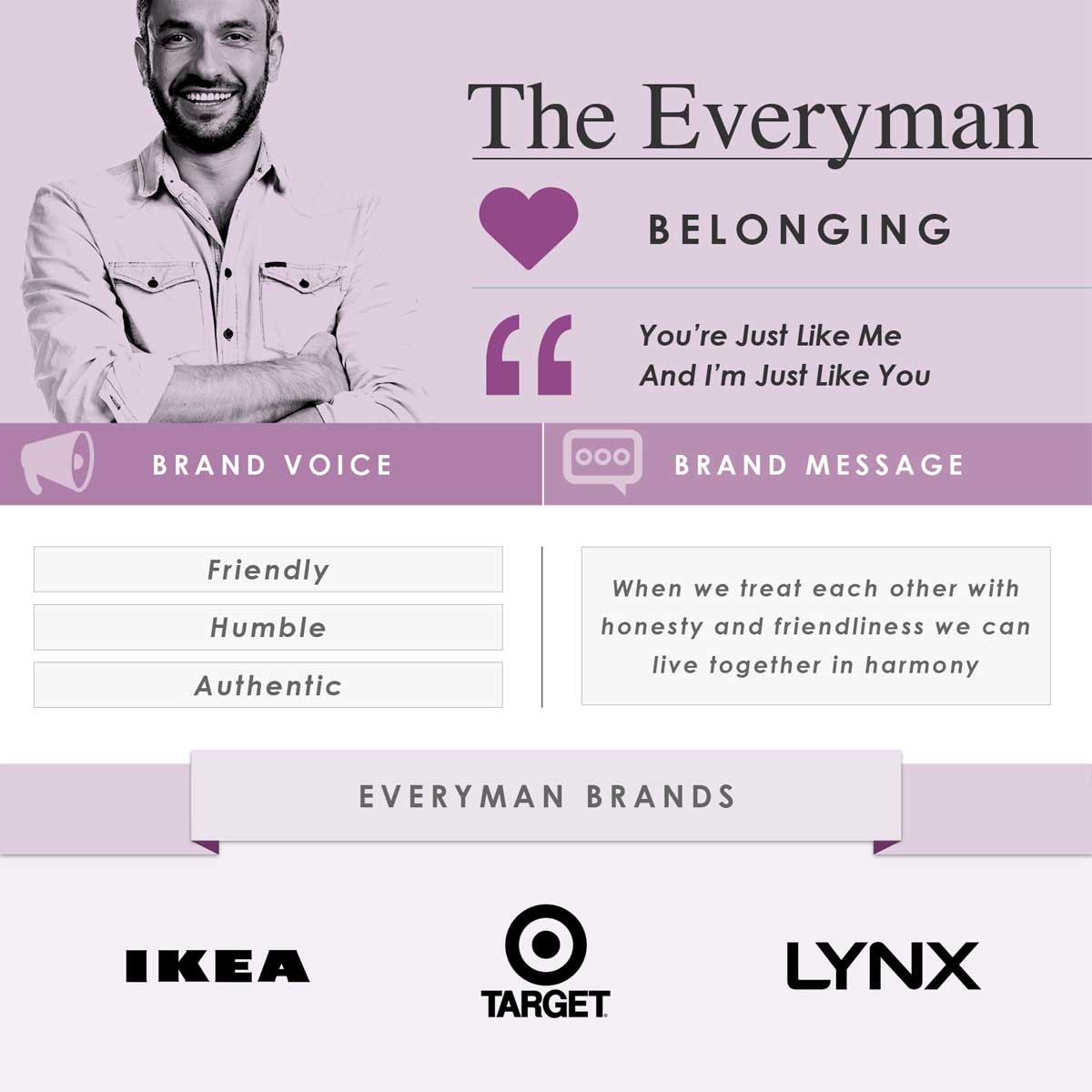
Explore Spirituality: Wisdom and Understanding-Oriented Archetypes
These archetypes appeal to customers seeking knowledge, wisdom, truth, or spiritual growth.
The Sage
- Core Motivation: To understand the world and share wisdom
- Personality Traits: Wise, knowledgeable, thoughtful, philosophical, analytical, truthful
- Brand Voice: Intelligent, thoughtful, authoritative, educational, reflective, honest
- Strategic Application: Educational institutions, consulting, media, research, and brands that help customers learn or make better decisions.
- When It Works: When you genuinely possess superior knowledge or insight that helps customers understand their world better
- Brand Examples: Google (organizing world's information), Harvard (educational authority), TED (sharing ideas and insights)
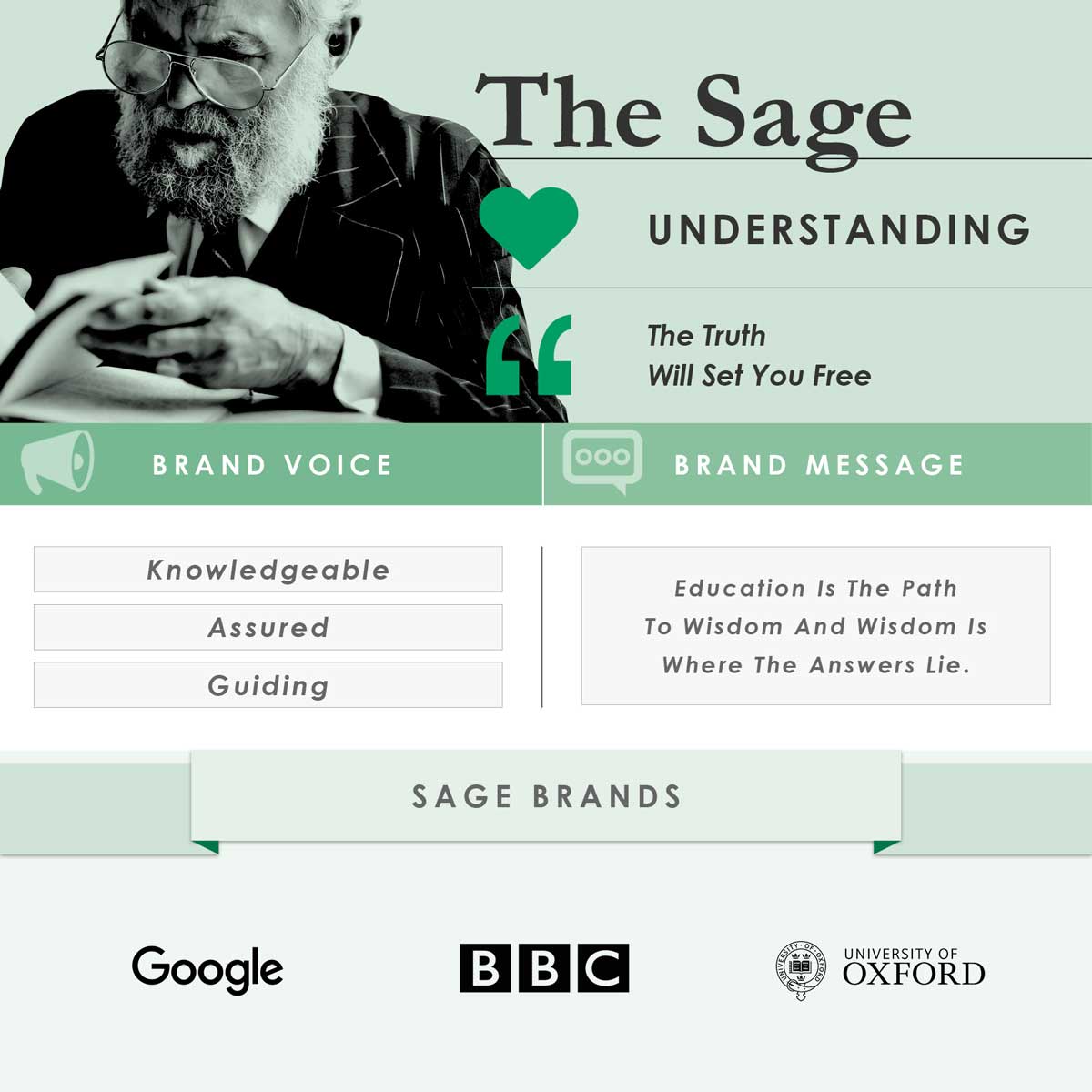
The Explorer
- Core Motivation: To experience freedom and adventure
- Personality Traits: Adventurous, independent, pioneering, authentic, restless, brave
- Brand Voice: Inspiring, adventurous, authentic, independent, encouraging exploration
- Strategic Application: Travel, outdoor gear, adventure experiences, and brands that help customers discover new possibilities or express independence.
- When It Works: When your product/service genuinely enables exploration, adventure, or authentic self-discovery
- Brand Examples: Jeep (off-road adventure), The North Face (outdoor exploration), Red Bull (extreme experiences)
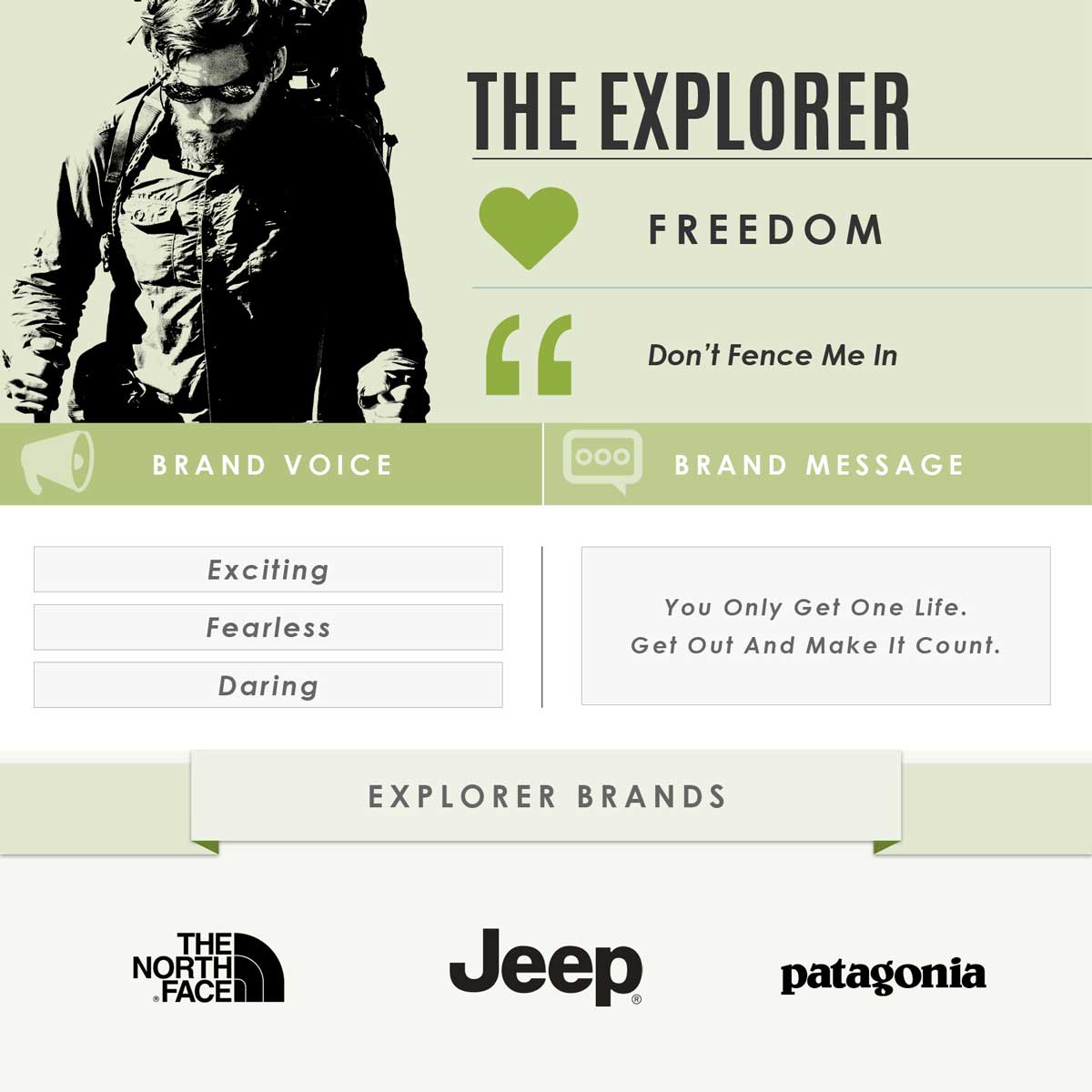
The Innocent
- Core Motivation: To be happy and live in paradise
- Personality Traits: Optimistic, pure, honest, trustworthy, hopeful, simple
- Brand Voice: Positive, encouraging, straightforward, humble, genuine
- Strategic Application: Perfect for brands that want to feel safe, pure, and reliable. Works exceptionally well for health, wellness, family products, and brands targeting parents or older demographics.
- When It Works: When your product/service genuinely makes life simpler, safer, or more pleasant
- Brand Examples: Dove (pure, gentle care), Coca-Cola (simple happiness), Innocent Smoothies (healthy, pure, optimistic)
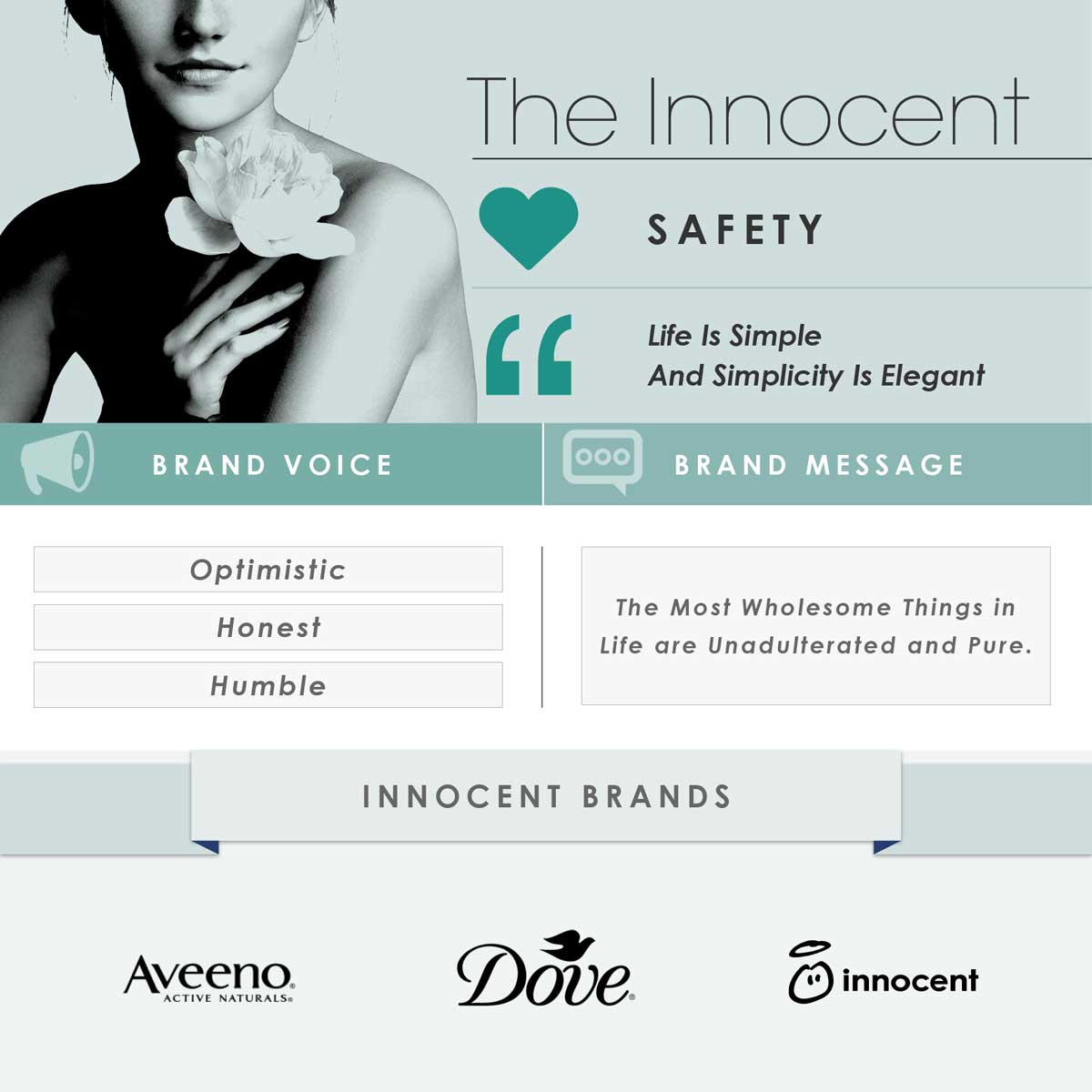
How to Choose Your Archetype Without Overthinking It
Most businesses fail at archetype selection because they choose aspirationally rather than authentically. They pick the archetype that sounds cool or prestigious rather than the one that aligns with their natural business model and customer needs.
Here's a three-step framework that actually works:
Step 1: Audit Your Natural State
Look at how you naturally communicate when you're at your best:
- What tone do you use when explaining your work to friends?
- What stories do you tell about your proudest business moments?
- What motivates you most about running your business?
- How do your best customers describe working with you?
Don't choose who you want to be—choose who you already are when you're operating authentically.
Step 2: Analyze Your Customer's Core Need
Different archetypes appeal to different psychological needs:
- Security seekers → Innocent, Everyman, Caregiver, Ruler
- Achievement driven → Hero, Outlaw, Magician, Creator
- Relationship focused → Lover, Jester
- Knowledge seeking → Sage, Explorer
Match your archetype to the primary emotional need your product/service fulfills, not just its functional benefits.
Step 3: Evaluate Your Competitive Reality
This isn't about being different—it's about being clear:
- What archetypes are your direct competitors using?
- Are they applying them consistently or just randomly?
- Where do you see opportunities for clearer, more authentic positioning?
- What archetype would feel most natural for your team to embody consistently?
The goal is strategic clarity, not creative uniqueness.
The Critical Warning Signs
Don't choose an archetype if:
- It requires you to fundamentally change your business model
- Your team feels uncomfortable or inauthentic embodying it
- It doesn't align with your actual customer experience
- You're choosing it primarily because competitors aren't using it
- It requires constant creative effort to maintain rather than feeling natural
Brand Archetype Masters: Lessons from Billion-Dollar Brands
Let's examine how three very different brands use archetypes strategically across all touchpoints:
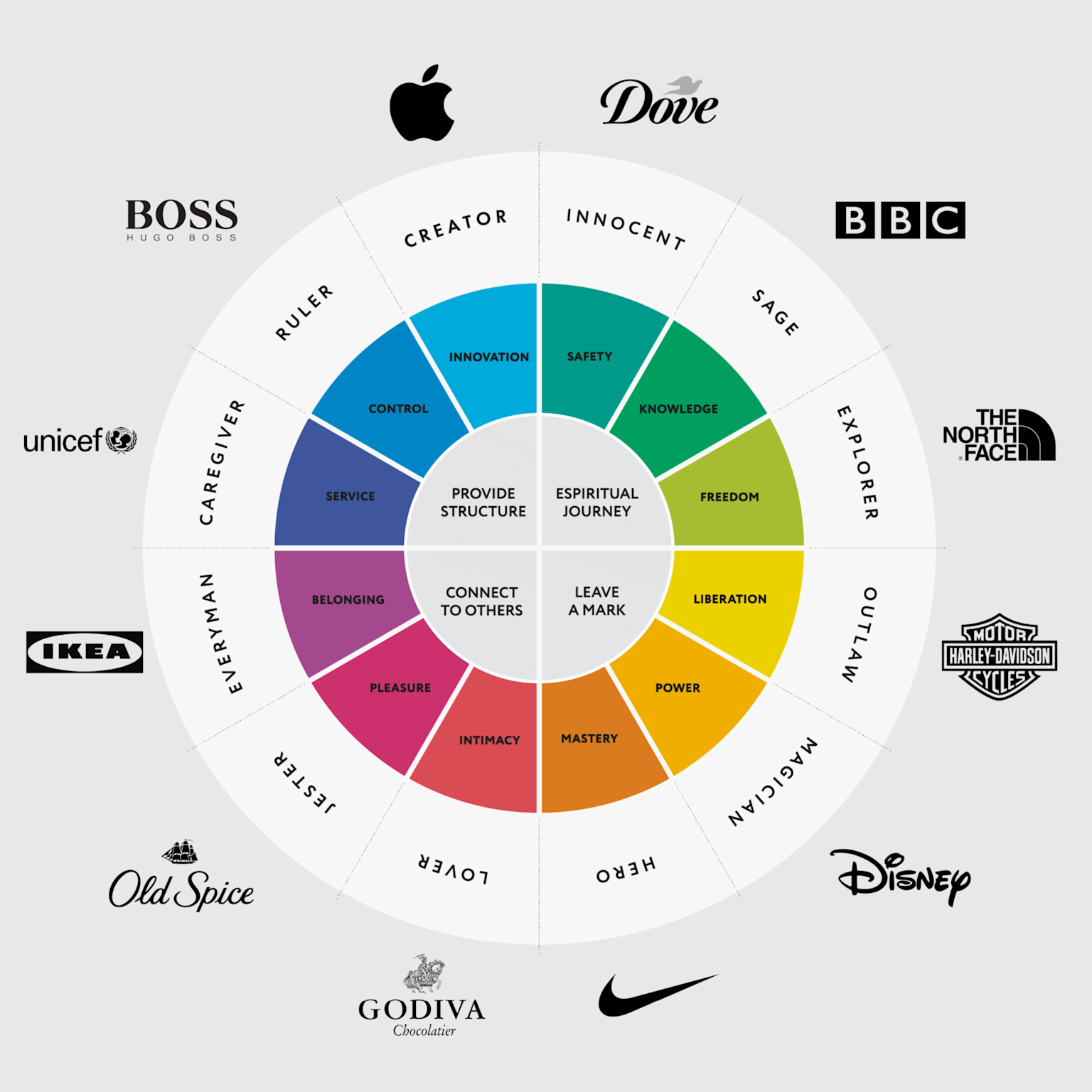
Nike: The Hero Done Right
Strategic Choice: Nike chose the Hero archetype because their entire business model is about helping customers overcome physical and mental challenges to achieve athletic goals.
Consistent Application:
- Advertising: "Just Do It" messaging consistently challenges customers to push past limitations
- Product Design: Performance-focused features that genuinely help athletic achievement
- Retail Experience: Stores designed like training facilities with inspirational athlete imagery
- Digital Platform: Apps and content focused on goal-setting, progress tracking, and achievement
- Partnerships: Sponsoring athletes who embody overcoming adversity and achieving excellence
Key Lesson: Nike's Hero archetype works because it aligns perfectly with their business model and customer experience. They don't just talk about heroism—they enable it.
Apple: The Magician's Systematic Magic
Strategic Choice: Apple embodies the Magician archetype by positioning technology as transformative rather than just functional.
Consistent Application:
- Product Launches: Events designed as magical reveals of life-changing technology
- Design Philosophy: Making complex technology feel simple and almost mystical
- Advertising: Focus on transformation and possibility rather than technical specifications
- Retail Experience: Stores designed as temples to technological wonder
- Brand Language: "Think Different," "Magical," "Revolutionary"—consistently transformative vocabulary
Key Lesson: Apple's Magician archetype succeeds because they systematically apply it to every customer touchpoint, from product design to packaging to customer service.
Harley-Davidson: The Authentic Outlaw
Strategic Choice: Harley-Davidson chose the Outlaw archetype because their customers genuinely value freedom, rebellion, and non-conformity.
Consistent Application:
- Product Design: Motorcycles that look and sound rebellious, not refined
- Community Building: Supporting rider clubs and events that celebrate outlaw culture
- Brand Partnerships: Aligning with rock music, tattoo culture, and other rebellious communities
- Marketing Messaging: Celebrating freedom, authenticity, and breaking away from convention
- Customer Experience: Dealerships that feel like biker hangouts, not car showrooms
Key Lesson: Harley's Outlaw archetype works because it's authentic to their product, their customers, and their company culture. They're not pretending to be rebels—they genuinely serve people who value rebellion and freedom.
Common Archetype Mistakes That Kill Brand Authenticity
After a almost a decade of watching businesses implement archetypes, we can predict exactly where most will fail:
Mistake 1: Aspirational Rather Than Authentic Selection
- The Problem: Choosing the archetype you wish you were instead of the one that aligns with your actual business model and customer experience.
- Real Example: A local accounting firm choosing the Magician archetype because they want to seem innovative, when their customers actually need the Caregiver archetype—someone who reliably protects and nurtures their financial wellbeing.
- The Fix: Choose based on your natural strengths and customer needs, not aspirational positioning.
Mistake 2: Marketing-Only Application
- The Problem: Using archetype language in advertising but not training it into customer service, product development, or operational procedures.
- The Reality: Customers experience your brand through every touchpoint, not just marketing materials. Mixed messages destroy trust faster than no personality at all.
- The Fix: Train your entire team to understand and embody your archetype in their specific roles.
Mistake 3: Archetype Mixing and Confusion
- The Problem: Trying to be multiple archetypes to appeal to different customer segments or situations.
- Why It Fails: Humans need consistent personality to build trust. A brand that's sometimes a Hero, sometimes a Caregiver, and sometimes a Sage confuses customers and undermines believability.
- The Fix: Choose one primary archetype and stick with it. You can have supporting traits from other archetypes, but one must dominate.
Mistake 4: Surface-Level Implementation
- The Problem: Changing your tagline and website copy but not your business processes, customer experience, or team training.
- The Reality: Archetype work is organizational transformation, not copywriting project. If your Hero archetype brand still has passive customer service and risk-averse policies, customers will notice the disconnect.
- The Fix: Align your operations, policies, and team behavior with your chosen archetype.
Mistake 5: Trend-Based Selection
- The Problem: Choosing archetypes based on what's currently popular in marketing rather than what serves your business strategy.
- Why It Backfires: Archetypes require long-term consistency to build trust. If you change your archetype based on marketing trends, you never build the deep customer connection that drives loyalty.
- The Fix: Choose your archetype as a 5-10 year commitment, not a quarterly creative campaign.
Stop Being Every Brand: Your Personality Is Your Strategy
Your archetype choice is not a creative exercise—it's a strategic business decision that affects every customer interaction.
Most brands fail because they treat personality as marketing decoration rather than operational foundation. They choose an archetype for their website copy but don't train their customer service team. They use Hero language in advertising but maintain Caregiver policies and procedures.
The brands that dominate their industries understand that archetype implementation is systematic, not superficial. Every touchpoint, from product design to billing procedures, should reinforce the same core personality framework.
This requires commitment: You can't be a Hero brand on Monday, a Caregiver on Wednesday, and a Sage on Friday. Customers need consistent personality to build trust, and trust is what transforms one-time buyers into loyal advocates who pay premium prices and refer their friends.
The strategic value is measurable:
- Faster customer recognition and recall
- Deeper emotional connection with your messaging
- Higher willingness to pay premium prices
- Stronger customer loyalty and reduced churn
- More effective team execution of brand voice
- Clearer decision-making framework for all communications
But here's what most businesses miss: The power of archetypes isn't in the framework itself—it's in having any consistent personality framework at all. The alternative to strategic archetype selection isn't creative freedom; it's generic, forgettable messaging that sounds like every other business in your industry.
Look at your current brand communications right now. Do they express a clear, consistent personality that customers can immediately recognize and connect with? Or do they sound like they could have been written by any company, for any industry, targeting any customer?
If your brand doesn't have a distinct personality, you don't have a brand—you have a business with a logo. And in a world where customers have infinite choices, personality is what transforms transactions into relationships.
Your archetype framework is waiting for you. The question is: Will you choose to be intentional, or will you continue to be forgettable?
The brands that succeed in the next decade won't be the ones with the biggest budgets or the most features—they'll be the ones with the clearest, most consistent personalities that customers genuinely want to build relationships with.

Discover Your Happily Ever After
Subscribe to get weekly updates on how you can start handling departmental plot holes in your story!

